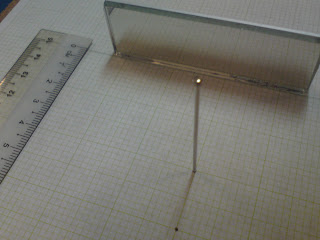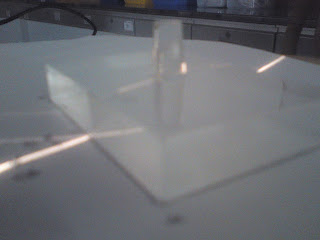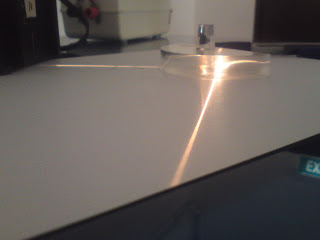- Term 1 Topics, Practicals and Reflections
- Excursions
- Term 2 Topics, Practicals and Reflections
- Pamphlets on Plants
- Term 3 Topics, Practicals and Reflections
- Article Review
Friday, September 14, 2012
Content
Article Review
One good quote in the article was “every time a new outbreak makes the headlines,
you can be sure someone is considering how to turn it into a weapon”, this
phrase shown the side of humans where they can turn every disease of infectious
virus into a weapon, were scientists from countries such as United States of
America, Canada, Soviet Union and many more hired scientists to research on a
kind of virus and expand it to a level of a biological weapon. Weapons range
from direct effect on human beings to the indirect harm on human beings by
cutting of food supply, in a range of many ways, this is my list from the most
powerful to the least powerful.
For the indirect biological weapons on humans will be
ranked respectively from worst to best, Rinderpest and Rice Blast. While those
that directly affect humans are Ebola Haemorrhagic Fever, Smallpox, Plague,
Tularaemia, Anthrax, Nipah Virus, Botulinum Toxin and the most devastating of
all the Chimera Viruses. Many of these viruses were outbreaks where some scientists
used it to find cures such as the Chimera when combined with polio could help
cure brain cancer. While others use the chance of every outbreak to find ways
to attack crops, respiratory systems and others too.
What I feel are the scary biological weapons are those
that could quickly kill people in a short amount of time, such as Nipah Virus
and Botulinum Toxin where the only chance to survive is to get botulism
antitoxin between 24 to 72 hours after you caught the virus. Another kinds are
those viruses which are more realistic to the society now which is rather more
newly invented, where it is not just a thing in the Scientific Fiction world,
which is not the case now, furthermore, there is no cure to the disease.
The Anthrax is another virus that, which in my opinion is
still a biological attack at large. In Civil Defence Force guide books to teach
us in a case of chemical attacks what shall we do, the Anthrax is illustrated
many times, where it is a white powdery substance where terrorists place in in
envelopes or bags and leave the items there. Once opened, the spores would
contact the skin causing them to get affected. Furthermore, this deadly weapon
is not like other bacterium which has a short “shelf-life”, Anthrax can stay
there for approximately 40 years and still remain as lethal as yet.
In conclusion, humans now use every single aspect of such
viruses to try to use it which is capable of destroying one another. Biological
weapons are intimidating viruses, bacteria and fungal spores naturally. These
instances started as early as 1500 BC, and even Genghis Khan accidentally
released Rinderpest, and till now the use of these biological weapons from
bacteria. However, even as biological weapons are now outlawed in 1972’s
Biological Weapons Convention and the Geneva Protocol, where many nations
destroyed their stockpiles, the lingering threat still remains.
This is the link to the article
Term 3
Reflection
As light falls on a surface, it will be reflected, this is a ray diagram. (image here)
As the light falls on a regular surface, it would be specular relfection.
As the light falls on a irregular surface, it would be diffused reflection.
The Ray Diagram
In the Ray Diagram, there is the "tedious way" and the "cheat method"
In the correct way, we have to measure every angle of the reflection before we can draw the virtual rays and the distance of the object from mirror and image from mirror. The human eye perceive light rays as straight and come from behind the mirror, thus it is called a "Virtual" image. Through this method, I can understand the reflection, however, if you were to do this for exam you might not have enough time thus...
(image here)
2P08
Practicals
2P07
- Angle of incidence, is equal to angle of reflection
- When drawing of concave mirror or convex mirror, always draw the tangent on the place of the incidence of light.
- When drawing lines for reflected ray, use two arrows on any two points of line

- Words to describe the image are real, virtual, diminished, same size, magnified, upright, inverted, laterally inverted
- When asking you to draw a reflection of word, always try to draw exactly the same
- Convex Mirror: stood close, image upright, diminished; stood far image upright, diminished
- Concave Mirror: stood close, virtual image upright, further virtual image and inverted.
2P09
2P10
- Semicircular glass block, the light ray enter from curved side
- Refractive index
- Refractive index for every glass is different
2P11
- 2mm of convex lens is considered as thin
- when the light ray enters the lens, you still have to draw tangent for every ray
- refraction will also occur to every ray when exiting the lens
- light ray does not stop at the focal point
- always do repeats of 3 times for each experiment
Refraction
Always remember this
Remember this too...
* As a light ray travels from an optically less dense to denser medium, it would bend towards the normal
* As a light ray travels from an optically denser to less dense medium, it would bend away from the normal
(image here)
(image here)
Lenses
- Case 1: parallel rays from a distant object u=infinity
- Case 2: the object is located beyond the 2F point
- Case 3: the object is located at the 2F point
- Case 4: the object is located between the 2F point and the focal point (F)
- Case 5: the object is located at the focal point (F)
- Case 6: the object is located in front of the focal point (F)
The terms used in Lenses
- Optical centre
Centre of lens
Principal axis
Focal Point
Horizontal line parallel to horizon, pass through optical centre
Pass through optical centre; meet at point, (parallel)
Focal Length
From the optical centre to focal point (length)
Focal Plane
Same line or plane as focal plane
Reflection
In this topic, many questions i had when i was young and questions that intrigued me had answers. An example was the lens which could cause a picture to be on the screen, this was something that was very interesting, as i also remembered seeing this when i was playing with a lens when i was young. (magnifying glass) This topic also cleared many thoughts, an example when i drink from a cup with a straw, the straw seems to be bended, but this is due to refraction as the light travels from a optically less dense medium to a optically denser medium. The practicals that i did are all very useful and hands-on. I got to try almost all of the theories that we use by having a try of it with our own hands, we could understand the rules/ theory better. This topic is indeed very interesting, I am planning to do more research and reading during my holidays.
Some Research on Plants and how to Grow them Better
This is My Brochure for Growing Bougainvillea
This is My Pamphlet for pH suitability for Snap Beans
I decided to do this research, as what we learned in term one was about the different pH water, and I wanted to learn more about pH water and its effects as i read many articles that plants thrive better in slightly acidic water.Thursday, September 13, 2012
Term 2
Reproduction in Plants
A Mind-Map for the Reproduction in Plants
Cross-Section of a Flower
Practicals
2P13
Some pictures in the Nature Trail around the School...
Pollination
How does the stigma recognise the Pollen.
The pollen grains are of a certain shape and size and they can send out chemical signals, as the pollen grains land on the stigma, if it is of the certain shape and size of the species, then fertilisation would occur.
Human Reproduction
Male Reproductive System
Structures
|
Functions
|
Male sex glands
|
Responsible for the secretion of
seminal fluid that can act as a lubricant and nutritive medium for the
sperm
|
Epididymis
|
Stores sperm temporarily
|
Penis
|
Used for copulation and releases
the sperm in the cervix of the female
|
Sperm duct
|
Conduct sperm to the urethra, by
peristalsis
|
Urethra
|
Carries sperm (during copulation)
and urine (during urination)
|
Testis
|
Produces sperm and male sex
hormones (testosterone)
|
Scrotum
|
Responsible for maintaining the
temperature of the testes, which is slightly below the normal body
temperature. This is important for the development and survival of the sperm.
|
Femal Reproductive System
Structures
|
Functions
|
Ovary
|
Produces eggs and the female sex
hormones (oestrogen and progesterone)
|
Uterus
|
Plays a part in the development of
the embryo and formation of the placenta
|
Oviduct
|
Provides the environment for
fertilisation to take place and conducts the fertilised egg to the uterus
|
Cervix
|
Opening to the uterus for the
passage of sperms. In addition, the baby emerges through it during birth
|
Vagina
|
Accommodates the penis during
copulation. Acts as the birth canal for the baby during birth.
|
Animation of the Menstrual Cycle
This is a easier version of the menstruation.
from the 1-5 days, menstruation occurs where the uterus lining breaks down)
5-14 days, uterus lining thickens
around the day 14 about day 11 to 16, "fertile days", would be the release of an ovum, however it only survives for 24 hours
day 14-28, *endometrium thickens (*tissues rich in blood capillary)
- this cycle dates can vary, as everyone is different such as the stress levels
- this cycles continues forever till menopause
Sexually Transmitted Diseases
| 1. AIDS
Information
Caused by the HIV virus that invades the immune system, resulting in "well carriers" to severe and fatal disorders. Spread: Contact with infected blood, semen, vaginal fluids mainly by unprotected sex and needle sharing and maternal transfer.
|
HIV Stage (1* - 14 years) - Flu-like symptoms may occur early or late - Most look and feel well for years - Infectious carrier - Skin & lung infections common in later years - HIV = antibody test indicates infection - 25% of infants born to HIV mothers will be infected |
Complications: - HIV progresses to AIDS Stage (2 - 5 years) - Immune system destroyed - AIDS defining illnesses fatal (pneumonia, cancer, dementia, wasting, cancer of the cervix) Treatment: - Yes - early treatment is best Cure - No |
| 2. GENITAL HERPES
(HSV)
Caused by a Herpes Simplex Virus with ulcerating blisters occurring on the genitals or anal area. May be spread to the mouth.
|
- Many people feel fatigued, and have a fever. - Painful blisters itch, redden the skin, form into groups and ulcerate. - Ulcers crust and may heal with scarring |
Complications: - The virus hides in nerve endings and reoccurs Treatment: - Yes (Acyclovir - no cure) Cure - No |
| 3. GONORRHEA
Info
Caused by bacteria that commonly infects the genitals, anus and throat.
|
- Most women show NO symptoms or some vaginal discharge, pain on urination, frequency Men usually notice thick yellow-green discharge from the penis, pain on urinating, pain in penis. Men and women if infected in the rectum have pain, bleeding and discharge. Sore throats if the throat is infected. |
Complications: Women: - sterility; pelvic inflammatory disease Men: - sterility, swollen testes - urinary infections Men and women may have heart, brain and liver infections, arthritis Treatment: - Yes (antibiotics) Cure - Yes, although some strains are resistant |
| 4. SYPHILIS
Information
Caused by the Treponema Pallidum bacterium which develop a staged disease over years. Highly contagious, but cannot survive outside the body. Affects the skin and any organ. Spread: By contact with infected blood, semen, vaginal fluids or pus.
|
Early stages shows painless sores, swollen glands and skin rashes. Sores may be inside the vagina or anus and go unnoticed. Stage 2. Rashes, new sores, flu-like symptoms, swollen glands, brain infection |
Complications: - Skin, bone, heart disease - Brain disease - Dementia - Blindness if left untreated Treatment: - Yes (antibiotics) Sex contacts must be examined Cure - Yes (with treatment) |
Reference:
Vaughn's Summaries
Birth Control
- Temporary methods allow the couple to still have children, if they stop using the methods, they can be natural or artificial.
- Natural methods are abstinence, withdrawal method and rhythm method
- Artificial methods include using of condoms, spermicide, birth control pills, intra-uterine devices and diaphragms
Reflections
This topic is something very important, as it is also sexuality education for students, it teaches many knowledge that will or might be very important to our lives. For the plant reproduction, we learnt of many ways how the plant fertilise where the processes are quite similar to humans such as fertilisation and so on. The cross section of the flower is something that i liked most in the topic, due to it being specific on the details, and also gives us more understanding. Many problems such as Sexually Transmitted Diseases could be caused if people do not practice safe sex, in which I learnt a lot, from how to keep myself safe. After these topics, my science knowledge has definitely improved, and what I learned are something that can be applied for the future.
Subscribe to:
Comments (Atom)


































































